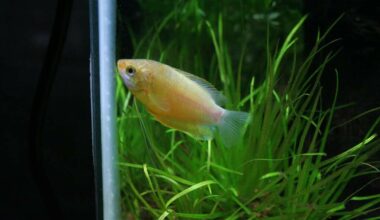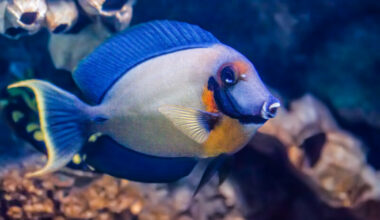The sunshine pleco (L014) is a species that many freshwater aquarists aren’t familiar with. But despite this, we think this is a fish that many people should consider!
This guide will teach you everything you need to know about the sunshine pleco. We cover care, lifespan, size, growth rate, diet, and more!
Table of Contents
Species Summary
The sunshine pleco (Scobinancistrus aureatus) is, without a doubt, one of the more vibrant members of the Loricariidae family. These fish look similar to other spotted pleco species at first glance. However, their distinct appearance becomes more evident the larger the fish gets.

This pleco goes by many names. You might see it called a “goldie” or by its simple L-number of L014. Either way, the most defining trait is the yellow coloration.
This fish originates from Rio Xingu in Brazil. It occupies oxygenated waterways, sticking to the bottom of the water column to scavenge for food. Compared to other types of plecos, sunshines are in high demand in the fish trade.
Not only are they more vibrant than most fish, but they stay a relatively manageable size which makes them easier to care for.
Appearance
It’s not hard to see why people call this fish the sunshine pleco.
Bright yellow dots cover the fish from its head to tail fin. The spots sit on a black or dark brown base, creating intense contrast. When young, the dots appear larger and more spaced out.
But when the fish reaches maturity, the pattern becomes denser. Pair that yellow accents on the belly and fins, and there’s plenty of vibrant coloration to appreciate.
This species has the same signature pleco profile. They have flat bellies, underturned sucker mouths, and an impressive set of fins. The fins all have spiny rays, and the dorsal fin stands tall like a shark fin.
The color pattern continues on the fins, but most fish have yellow or bright orange edging. You might also notice a spotless yellow belly.
Author Note: Males and females are nearly identical. The males tend to grow larger. Their heads are also blockier.
Lifespan
The average lifespan of a sunshine pleco in captivity is roughly ten years. However, many owners are lucky enough to keep their fish healthy for upwards of 15 years!
There’s no guarantee either way, but the quality of care you provide matters. Sunshine plecos in pristine living conditions are more inclined to live closer to 15 years. Meanwhile, fish with poor diets and dirty tanks might succumb to disease much earlier.
Average Size
The average size of a sunshine pleco is about 12 inches. Some might get slightly bigger, while others max out at 10 inches. There’s a bit of variation, but 12 inches is the standard.
That might sound pretty big for a freshwater fish living in captivity. However, it’s far smaller than other popular pleco species (and their growth rate is manageable). For that reason, sunshine plecos are the go-to choice for aquarists who want a fish that can live in standard-sized tanks their entire life.
Sunshine Pleco Care
Sunshine pleco care isn’t too difficult. These bottom-dwelling fish are surprisingly hardy and can adapt to most standard aquarium conditions.
But as always, the best course of action is to meet your fish’s needs to a tee. They have their preferences and care requirements like any other pet.
Here are some guidelines for proper sunshine pleco care to help keep your fish healthy for years to come.
Tank Size
A full-grown sunshine pleco needs a tank size of at least 120-125 gallons. You can start smaller with juveniles, but you’ll need to upgrade relatively quickly. Most aquarists prefer to start with a larger tank to give their plecos plenty of room to roam.
Author Note: Around 125 gallons is the minimum, but you can go bigger if you have the means. These freshwater fish need ample space, but they’re small enough to live in larger tanks rather than requiring open ponds.
Water Parameters
The best course of action when setting tank parameters is to mimic the fish’s natural habitat. The sunshine pleco comes from fast-moving waters in South America. They’re used to warm temperatures, plenty of oxygen, and good water quality.
These fish can produce substantial waste. As a result, it’s important to monitor conditions regularly and work to maintain stable water parameters.
- Water temperature: 74 to 84 degrees Fahrenheit (Upper 70s is ideal)
- pH levels: 6.0 to 7.2 (Aim for relatively neutral water)
- Water hardness: Up to 30 dKH
Author Note: As always, invest in a reliable aquarium water test kit so you can accurately measure these parameters. Inaccurate readings are just as bad as no readings at all!
What To Put In Their Tank
A well-designed tank is crucial for enrichment and comfort. Sunshine plecos spend all of their time roaming the bottom of the water column, so spending extra time getting things right pays off.
Begin with a layer of fine substrate material. Sand is the best choice, but pea-shaped gravel works well, too. Add some rounded rock to give the floor dimension. Then, install rock work and driftwood.

Use natural-looking decor to create small caves and little areas for your pleco to hide. When threatened, L014 plecos like to wedge themselves in crevices and caves. They’ll expand their fins to stay put.
Add several hiding places to give your pleco the chance to live as they normally would in the wild. You can add live or artificial plants, but it’s not necessary. These plecos sometimes ruin plants with their rummaging behavior.
Common Possible Diseases
Sunshine plecos are hardy, but they can experience all the common diseases you would expect from freshwater fish.
The most common ailment to plague these plecos is ich. Ich is a type of parasitic infection. It causes white spots to form all over the body.
Ich is highly contagious, so quarantining your fish is a must. Luckily, the disease is easy to treat with copper-free medicines and salt.
A L014 sunshine pleco can experience fungal infections and stress-related issues if water conditions aren’t safe. As mentioned earlier, these fish produce a lot of waste. Perform regular water changes and check ammonia and nitrate levels to avoid complications.
Food & Diet
Contrary to popular belief, sunshine plecos can’t survive on algae alone. Despite their sucker mouths, these fish aren’t the most prolific algae eaters. They will sometimes snack on wood, but they need traditional foods like any other fish in your tank.
Sunshine plecos are omnivores that thrive on a nice mix of protein-rich food and vegetables.
For protein, try bloodworms, shrimp, and tubifex worms. Live, frozen, and freeze-dried work well. You can also provide snails! The pleco’s strong teeth make quick work of the shell.
You can provide peas, spinach, zucchini, and more for vegetables. Blanch the vegetable first and give it to your fish skin and all. These plecos love to consume vegetable skin.
Balanced commercial foods are good for sunshine plecos, too. Stick to sinking pellets to ensure that the food makes it down to the pleco before tank mates get to it.
Ultimately, a balanced mix of foods is ideal for providing your fish with a balanced diet.
Behavior & Temperament
Sunshine plecos are relatively easy-going. They’re primarily nocturnal, and when you first bring them home they might not come out or move during the day at all.
However, many plecos will adjust their circadian rhythm to be more active in the daytime if there are ample shade and hiding places.
Sunshine plecos do have a reputation for being territorial. They can scuffle with other bottom-dwellers, so you must be careful about tank design and compatible pairings. If you plan on having multiple L014 sunshine plecos, make sure to have a large tank with several hiding spots.
Sunshine Pleco Tank Mates
The best tank mates for the sunshine pleco are those that inhabit the same environment in the wild. Stick with South American fish that require the same living conditions.
Sunshine plecos stay at the bottom of the water column and usually pay no mind to other fish. As a result, you can pair them with cichlids, discus, and other fish occupying higher tank parts.
The only limitation is keeping the bottom peaceful. Avoid any aggressive or territorial fish and have several shelters.
- Discus
- Angelfish
- South American Cichlid species
- Rainbowfish
Breeding
There are no current methods for breeding sunshine plecos in traditional aquariums.
Some breeders have successfully bred these fish in captivity. However, the required triggers and environmental parameters aren’t viable for standard fish tank setups. As a result, it’s currently not possible to intentionally breed sunshine plecos in captivity.
If an effective and safe method emerges, we will be sure to update this guide with the information!
Conclusion
Now that you’re familiar with the fundamentals of sunshine pleco care, it should be pretty obvious that this is not a species that should intimidate you. As long as you’re able to provide them with a tank that’s large enough, ensuring that these fish thrive won’t be a challenge.
If you have any questions about this species, feel free to send them over. We’re always happy to help!

